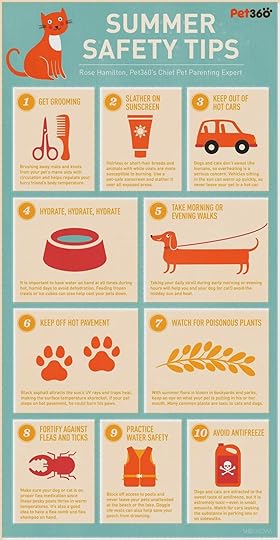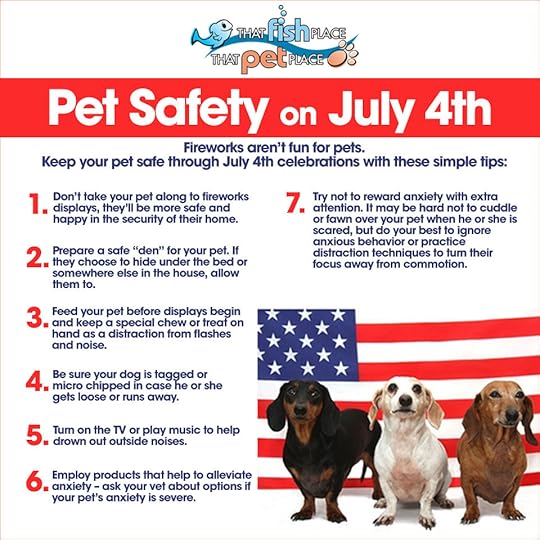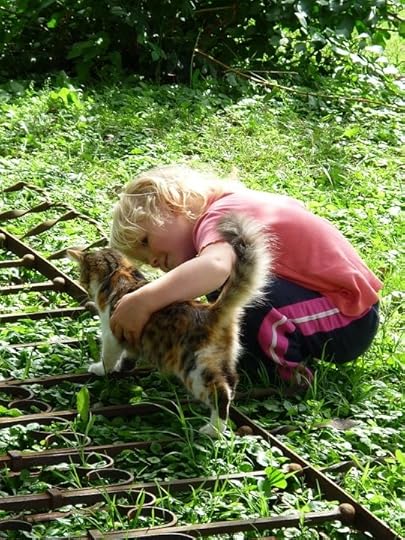Gayle Irwin's Blog, page 21
July 11, 2017
5 Tips for dealing with summer's heat
 The heat of summer is upon a lot of us, with scorching temperatures of 95+ – and it’s barely July! Such temperatures are hard on people as well as pets. Like humans, pets need to keep cool, so running fans and air conditions in the home not only benefit us, but also benefit our pets. Like people, pets can experience heat exhaustion and heat stroke, so be aware of your pets’ health as you combat the heat.
The heat of summer is upon a lot of us, with scorching temperatures of 95+ – and it’s barely July! Such temperatures are hard on people as well as pets. Like humans, pets need to keep cool, so running fans and air conditions in the home not only benefit us, but also benefit our pets. Like people, pets can experience heat exhaustion and heat stroke, so be aware of your pets’ health as you combat the heat.Here are five tips for helping your pet deal with this year’s sweltering heat:With the extreme warm temperatures, sidewalks and roads become incredibly hot, therefore, walk your dog early in the morning or later in the evening, and preferably on grass instead of pavement.Don’t leave your pet outside for long periods of time, especially during the afternoon hours.Provide plenty of fresh water, whether your animal is indoors or outdoors. Just like people, pets can become dehydrated due to summer’s hot temperatures.Provide cool, circulating air in your house for your pets, especially while you’re gone to work or other activities.Don’t play with your pet during the heat of the day, even if s/he seems to want to play. Playtime, like walk time, should be done when the temperature is cooler, such as morning hours.
Also remember to not take your pet in the car and leave them there during the summer. Humans cool themselves by relying on an extensive system of sweat glands and evaporation; dogs and other animals have a more difficult time staying cool, therefore, they are very vulnerable to heat exhaustion and heat stroke, which happens frequently when pets are left in vehicles.
Parked cars quickly trap the sun’s heat. According to various studies done, a vehicle’s indoor temperature can rise 20 degrees F in just 10 minutes. In 20 minutes, it can rise almost 30 degrees, and in 60 minutes, it can rise nearly 40 degrees. Even on a 70-degree day, if you leave for an hour, your car can be 110 degrees inside. Even having windows down somewhat makes little difference. Rarely does a summer go by without the tragic death of pets left in parked vehicles. Visit MyDogIsCool to learn more and print flyers to help others.
There are still many weeks left in the Summer of 2017, which means a lot more days of blistering temperatures. Let’s do all we can to make the season as comfortable and safe for our beloved pets as we can!

Published on July 11, 2017 05:30
July 2, 2017
Summer + Cars/Fireworks + pets Can = Tragedy
 Every summer first responders are called to the scene of a child or pet left in a car. Already in 2017, 15 children have died, most of them in Texas. Pets, especially dogs, suffer the same deadly fate, and K-9 units are not immune; even in my own community, a K-9 four-legged officer named Nyx died after left in a hot car three years ago. Although it’s fun for us to take our pets on a car ride, summer is not the best season to do so. Summer and pets and cars can lead to tragedy, so it’s best to leave your furry companion in the coolness of the house while you are out and about.
Every summer first responders are called to the scene of a child or pet left in a car. Already in 2017, 15 children have died, most of them in Texas. Pets, especially dogs, suffer the same deadly fate, and K-9 units are not immune; even in my own community, a K-9 four-legged officer named Nyx died after left in a hot car three years ago. Although it’s fun for us to take our pets on a car ride, summer is not the best season to do so. Summer and pets and cars can lead to tragedy, so it’s best to leave your furry companion in the coolness of the house while you are out and about.The hot season poses another threat to our pets: fireworks. Although we humans may think the colorful display to be amazing and we tend to ignore the noise, the flashes, booms, and shrills of fireworks upset many pets. A dog’s ears are more sensitive than a human’s; in fact, dogs hear higher frequencies than people and they hear much better than we do. Therefore, the noise from fireworks is worse for them. During the 4th of July week, many pets escape, becoming lost, which can lead to death being hit by a car or land the animal as a stray at the city shelter/pound. In fact, reports say shelters receive more animals during the 4th of July week than any other time. Therefore, keep your pets secure in a room in your home with comforting things like its pet bed and toys, as well as food and water. Give your pet a safe place to be inside your home while firework displays, sparklers, and other 4th of July paraphernalia are being used.
There are many things you can do to help your pet be safe during this time of year; here are few ideas:Remember that pets are vulnerable to heat exhaustion and heat stroke, and if let in a parked car where the temperature can rise 20 degrees in just 10 minutes, your furry friend can die – therefore, keep your pet at home while you run errands, eat out, etc.Many states and municipalities have laws regarding pets left in vehicles during the warmer months of the year, some even designating the leaving of a pet inside a vehicle on a warm day as animal cruelty – another good reason to leave Fido and Fluffy at home.If your dog or cat is afraid of noise, like thunder and fireworks, the Thundershirt can provide a sense of comfort.Leave soft music on the TV or stereo for your pet while you’re out enjoying fireworks, which will help mask the loud noises going on outdoors.If your pet spends time outdoors during the hot days of summer, make sure there is a plenty of shade from trees and fresh water outside.Walk your dog during the cooler parts of the day, such as mornings and late evenings.Provide plenty of water for your pet during this hot season of the year whether they are outdoors or indoors.
Learn more summer and Fourth of July safety tips at these websites:
https://www.petfinder.com/pet-care/summersafetytips/
http://aldf.org/cases-campaigns/action-alerts/dogs-in-hot-cars/
https://www.avma.org/public/PetCare/Pages/July-4-Safety.aspx
Have a wonderful week!


Published on July 02, 2017 06:00
June 27, 2017
be prepared during pet preparedness month
 Although June is drawing to a close, this week is still a great time to remind pet parents that the month highlights the importance of being prepared for an emergency, not only for you and your human family, but also for your four-footed family members. June is Pet Preparedness Month, and whether the disaster is flooding, tornadoes, earthquakes, fires, or other natural calamities, being prepared is critical.
Although June is drawing to a close, this week is still a great time to remind pet parents that the month highlights the importance of being prepared for an emergency, not only for you and your human family, but also for your four-footed family members. June is Pet Preparedness Month, and whether the disaster is flooding, tornadoes, earthquakes, fires, or other natural calamities, being prepared is critical.The federal government provides a website regarding preparedness and pets. Visit https://www.ready.gov/animals to learn about making an emergency plan for you and your pet, creating a shelter for your animal, and caring for your furry friend after an emergency.
The primary tip to get you started with emergency pet preparedness is to create a bag or pack (known as an “evac-pack"). Here are some of the things you should have in that “go-bag:”7 days-worth of food (rotate regularly and if you use canned food, buy cans with a pop-top)7 days’ supply of bottled water (rotate regularly)Medication (rotate regularly)Food/water bowlsExtra collar, harness, and leashClean up supplies (pet cleaning solution and paper towels)Plastic bags (to serve double duty as garbage and poop bags)FlashlightBlanketToys and chewsCarrierCopies of medical recordsRecent photo for making lost postersFirst aid kit with pet-specific supplies
The ASPCA provides further information on evac-packs as well as gives more disaster preparedness information. Visit their website at https://www.aspca.org/pet-care/general-pet-care/disaster-preparedness to learn more.
Additionally, AKC Reunite offers opportunity for county emergency management officials to obtain trailers to help pets during a disaster. Sadly, many states do not have a disaster relief trailer yet, especially those west of the Mississippi. Last year, my community received one of these important vehicles, the first and only one in the state; read the story here: http://casperjournal.com/community/article_02aad1db-1ae5-53d5-a5b8-b0822782a248.html
As rain falls, tornadoes and hurricanes break out, and wildland fires begin to crop up, let all of us who are pet parents think of our furry children as we plan for emergency situations.

Published on June 27, 2017 05:00
June 20, 2017
blending a furry family
 Many people enjoy having more than one pet in the household, but adding another animal can come with challenges. Some dogs are more domineering than others, yet you don’t want an overly aggressive dog who won’t allow your second canine friend to eat or play with the toys. And, if you have cats, you’d like to see your feline friends get along. Or, if you have a mixture of dogs and cats, you’d prefer the dog not aggravate or chase the cat… or the cat to constantly swatch and scratch the pup. Just like blending human families, blending a furry family can take a great deal of patience and a lot of time. Be prepared to work with your animals in order to experience harmony in your home.
Many people enjoy having more than one pet in the household, but adding another animal can come with challenges. Some dogs are more domineering than others, yet you don’t want an overly aggressive dog who won’t allow your second canine friend to eat or play with the toys. And, if you have cats, you’d like to see your feline friends get along. Or, if you have a mixture of dogs and cats, you’d prefer the dog not aggravate or chase the cat… or the cat to constantly swatch and scratch the pup. Just like blending human families, blending a furry family can take a great deal of patience and a lot of time. Be prepared to work with your animals in order to experience harmony in your home.We had a dog named Cody, a cocker spaniel we adopted from our local humane society in 2008. He was wonderful with our blind springer spaniel, Sage, but she took more time to acclimate to Cody living with us. And, Cody was terror for our two cats. We didn’t properly introduce Cody and the cats, and for several weeks, even into a second month of living with us, Cody chased the cats every time he saw them. Finally, one of our kitties had enough and she swatted his face. That’s all it took and the chasing ceased. It was still another month before harmony set in but it did happen.
After Sage passed, we waited another year to obtain another dog, and this time we chose one who had been around, and therefore, was good with, both dogs and cats. Mary became our next dog, adopted in 2013, and she and the kitties get along wonderfully!
Cody passed away in January 2016. In October, I brought home a small Pekinese mix named Lemmons, again from our local humane society. He had not been around cats, but the shelter staff “tested” him by taking him into the cat room; Lemmons behaved well. And, when I brought him home I introduced him properly to the cats, taking things slowly and having them sniff each other through closed doors. All seemed to be going well. Then, the day I let Lemmons and our cat Murphy near each other, he lunged for the back of her neck. Too much trauma and drama, so I decided he would do best in a home without cats. He had also snapped at Mary a few times. Lemmons was later re-homed through the humane society with someone who had no other pets and to my knowledge, he’s doing much better in that setting. And, my household is harmonious once again.
Sometimes blending furry ones into one household doesn’t work and a person must make the decision that is best for all animals (and humans) of the household. There is the right home for that animal; it just might not be yours.
As my husband and I once again consider adopting another dog – Mary is lonely as the only dog in the house; she had a smaller pup friend in the household before ours and then of course, she had Cody when she first came to live with us – we will once again seek a smaller dog that has been in a multi-pet home. We are hoping to find our next furry friend later this year, possibly another Cocker Spaniel, a Cavalier King Charles spaniel, a Bichon Frise, or a Shih Tzu. Each breed is different, in personality, in activity level, and in requirements, just as people are different. So, I’m studying, I’m asking questions, I’m researching. Petfinder.com is a great way to find a new furry friend and the various rescues and shelters in my region are also excellent organizations to contact.
If you’re looking for a feline or canine companion, visit your local rescues and shelters and check out Petfinder as well. Just remember that blending a furry family takes time and patience so do your homework first for the right breed and the right individual.

Published on June 20, 2017 16:30
June 13, 2017
Ways to Help Cats During Adopt-A-Cat Month
 June is Adopt-a-Shelter-Cat Month, a time to bring to light the millions of cats who are in need of homes. Because spring and early summer are considered “kitten season,” a time when thousands more cats and kittens need care and new homes, animal shelters and rescues across the country designate June as Adopt-A-Shelter-Cat Month.
June is Adopt-a-Shelter-Cat Month, a time to bring to light the millions of cats who are in need of homes. Because spring and early summer are considered “kitten season,” a time when thousands more cats and kittens need care and new homes, animal shelters and rescues across the country designate June as Adopt-A-Shelter-Cat Month.Here is a short list of things you can do to help, whether or not you can adopt:
If you’re able and have been thinking about adding a cat to your home, this a good time to do so. Many shelters and rescues reduce their adoption fees for cats during this month. So, if you can, adopt a cat in June.Contact your local rescue or shelter and learn what their wish list is and then donate things like cat litter, cat food, and cleaning products, or other items on that list.Donate money to your local shelter or rescue. Not only do these groups need funds for organizational costs, but medical vet bills can pile up, especially with the added number of litters of kittens brought in.Sign up to be a foster parent to help the shelter rescue and save more mamma cats and their babies.Volunteer at your local rescue or shelter, playing with the cats (or walking the dogs), or however else the organization may need volunteers to serve.Spay and/or neuter your own pets, including your cats, and encourage your friends and members of your community to do the same. Don’t add to the cat overpopulation (and therefore, death) problem.Spread the word about kindness by talking with your children, your friends, and others about cat adoption, volunteering, and donating during this month.
By helping organizations that help cats, whether it’s through actual adoption, by volunteering, through community education, or by donating funds and supplies, you are helping cats in need during this special time of year.

Published on June 13, 2017 06:00
June 6, 2017
The Benefits of Living with a Cat
 Science has proven that having a pet has many health benefits for people, including lowering one’s risk of cardiovascular disease. Some of that is attributed to walking and other exercise activities with a dog. But, what about cats? Does living with a cat benefit a person?
Science has proven that having a pet has many health benefits for people, including lowering one’s risk of cardiovascular disease. Some of that is attributed to walking and other exercise activities with a dog. But, what about cats? Does living with a cat benefit a person?The answer is YES! According to PetMD’s daily Vet Blog, owning a cat also has health benefits. Those include reducing stress levels and blood pressure, which can also help reduce cardiovascular disease. Having a cat can also reduce the risk of depression. Having a furry companion eases loneliness and helps a person unwind and decompress after a rough day at work or school. Cats provide special companionship, and though they tend to be more loners than dogs, cats are also affectionate and playful, helping people not feel so alone and helping them be active, even if it’s just tossing a ball or a catnip mouse across the room. In fact, cat companionship seems especially beneficial to people who live alone or are widowed.
Additionally, a 20-year study found that people who live with cats were 40% least likely to die from a heart attack, and cat owners visit doctors 12% less frequently than non-cat-owners.
Although some people are allergic to cats, exposure to dander and fur in the house can “result in increased resistance to allergens, decreasing risk for allergies and asthma,” according to Health Fitness Revolution.com.
A psychological study showed that children who grow up with pets, including cats, tend to have greater compassion, empathy, and higher self-esteem.
Two different friends have added cats to their homes in the past few years. One adopted an adult male cat, the other obtained a female kitten. Both agree the benefits of companionship, laughter, and relaxation and much more come with living with a cat.
A cuddle with your kitty, a purring lap sitter, or a frisky game of chase the feather chases away the blues and provides fun and laughter. A cat is a wonderful companion, and in its unspoken way benefits a pet parent in a variety of ways.
So, hug your kitty today … and if you don’t have one or are thinking of adding another to your home, adopt one today! June is Adopt-a-Shelter Cat Month, a great time to consider adding a feline friend to your family – there are millions in need of homes, and you can be one of those life-saving heroes. Both you and the cat will benefit.

Published on June 06, 2017 06:00
May 29, 2017
Home Alone: Helpful Hints for Working Pet Parents
 Face it: Pets cost money, just like human kids, and the adults in the family must work to take care of them (well, the vast majority of us do). So, we leave our furry friends home alone for hours on end. Although our pets may not have the adventures of those in the movie “The Secret Life of Pets,” oftentimes our furry companions get lonely, and sometimes they become destructive.
Face it: Pets cost money, just like human kids, and the adults in the family must work to take care of them (well, the vast majority of us do). So, we leave our furry friends home alone for hours on end. Although our pets may not have the adventures of those in the movie “The Secret Life of Pets,” oftentimes our furry companions get lonely, and sometimes they become destructive.What’s a working pet parent to do? Here are a few suggestions:
For Dogs: Fix a special spot, perhaps a separate room, like a spare bedroom. In that room, place familiar and enjoyable items for your pet, like a bed, some toys, and maybe a crate if your dog is crate-trained. And, don’t forget food and water. You may want to gate off the remainder of the house to keep your dog from destroying other areas of the house.Special toys that engage your dog’s senses are very helpful. KONG and BobaLot Interactive are treat-dispensive toys that provide many hours of fun; hiding a few of these around the house (or room) will engage your dog’s sense of smell and trait of seeking/hunting.Safe chews, like Nylabones, will occupy your pet’s time while you’re gone. Other chews can be hazardous and shouldn’t be given to your pet without supervision.If possible, go home for lunch and spend ten minutes with your dog, playing fetch in the backyard or going for a brisk walk.Separation anxiety is common in many dogs, and the Thundershirt is an item that can help keep your pet calm, not only while you’re gone, but also during thunderstorms. Learn more about separation anxiety here: https://www.aspca.org/pet-care/dog-care/common-dog-behavior-issues/separation-anxiety.
For Cats:
Cats can jump gates and aren’t likely to stay in one room unless you close the door – and then who knows what you’ll come home to? Therefore, confining them isn’t the ideal. Instead consider these thoughts:Set up climbing posts in different rooms and place them near windows.Set up bird baths and/or bird feeders outside the windows your cat can look out of; observing and hearing flickers of nature will keep your kitty engrossed for hours.Provide toys, such as catnip mice, KONG kitty teat toys, and mice/ball round pounce rings – all of these engage your kitty’s sense of hunting while scratch pads and posts keep your furniture from being frayed, and tunnels offer opportunities to run through, and with a mouse or two inside or even some treats, even more exercise prospects.Some people construct special platforms in their house on which cats can climb, jump, run, and even sleep. Here’s an example: https://www.youtube.com/watch?v=okOVxfuSYPkOffer your cat a comfy bed, made all the better when put in closet, drawer or other “hiding place.”
Cats sometimes also suffer from separation anxiety; Thundershirts are also available for them!
Other ideas to help keep your pet from being too lonely or bored include leaving the TV or radio on with soft, soothing music, and hiring a pet sitter or taking your furry friend to daycare; Rover.com, Care.com, and CatVacay can assist in finding a good sitter or daycare facility.
Find more ideas about keeping your pets from being too lonely or bored by visiting these websites:
https://www.rover.com/blog/field-guide-working-dog-owners/?utm_medium=email&utm_source=Responsys&utm_campaign=052617190001&utm_content=B_04_05_OwnerNewsletter&utm_term=052617
and
https://www.petcha.com/7-tips-to-keep-your-cat-from-being-bored/

Published on May 29, 2017 06:00
May 23, 2017
Pet Nutrition: Carefully Consider What You Feed Your Four-Legged Companion
 I wrote a blog post earlier this year regarding keeping our pets healthy by feeding them quality food. Whether you’re just adopting a new pet or you have lived with your furry friend for many years, proper nutrition is a good way to ensure a healthy pet. Since that post back in January, I’ve been approached by a few pet food reviewing sites with added information; therefore, I’m re-posting part of that article and adding some information they provided.
I wrote a blog post earlier this year regarding keeping our pets healthy by feeding them quality food. Whether you’re just adopting a new pet or you have lived with your furry friend for many years, proper nutrition is a good way to ensure a healthy pet. Since that post back in January, I’ve been approached by a few pet food reviewing sites with added information; therefore, I’m re-posting part of that article and adding some information they provided.Obesity in pets, like humans, is on the rise. Activity, or lack thereof, plays a role; so does food. Additionally, pet food and treat recalls are, sadly, very common. The ingredients in pet food has become more and more questionable, especially for products made outside of the United States; however, even pet food and treats made in the USA have problems. Purina, a well-known company based in St. Louis, Missouri, had a large class-action lawsuit brought against it in 2015, and Diamond, which has incorporated many small brands, experienced many recalls, including a large one in 2012. How can we as pet owners ensure our beloved animals are receiving quality nutrition? By reading research.
The website HerePup recently posted a review of dog food brands. The article includes other important, relevant information, such as what foods dogs should and should not eat, best types of foods for specific diets and health issues, and dog foods for specific dog breeds. You may find this information very helpful since the post is from earlier this month: https://herepup.com/dog-food/
In March 2017, Reviews.com updated a report from the previous year regarding dog food brands, interviewing pet owners and food researchers. In that report, they listed dog food brands that they believe provide the best nutrition and have the safest ingredients. Although lengthy, the report is filled with important information for dog owners. I discovered that a brand recommended by my veterinarian for my allergy-afflicted dog is NOT on the list; in fact, that brand, Royal Canin, was cut from the “good quality” list because of the ingredients. Other often vet-recommended foods, such as Hills Science Diet, was also on the “naughty list.” Two foods which are sold at one of my local pet supply stores, one at which I worked part-time several years ago, is on the “nice list;” those foods are Fromm and Nature’s Logic. I will likely explore these brands as options for my dog. Read the entire report at this website: http://www.reviews.com/dog-food/.
Reviews.com also produced an updated report regarding top-quality cat food. The researchers analyzed the ingredients of 1,700 cat food formulas and examined more than 100 brands. They came up with a list of top 10 cat foods, all from different companies. They eliminated foods with artificial ingredients, preservatives, and dyes. Once again, Royal Canin made the “naughty list” as did many others, including Natural Balance, Purina, Meow Mix, and Iams. Read this important report and learn what brands were given top ratings and why at this website: http://www.reviews.com/cat-food/.
Although many of the top brands of dog and cat food are higher priced than Purina or other grocery store-type foods, if your pet experiences health issues, such as kidney failure, due to ingredients in its food, what savings are you gaining should you incur high veterinary bills? Or worse, your pet dies?
Giving our pets quality nutrition is as important for their health as us eating good food is for our own health. Consider these reports and reviews to help you select the best food for your best furry friend!

Published on May 23, 2017 05:00
May 16, 2017
Five Ways to Choose the Right Pet
 Animal shelters and pet rescue groups throughout the country take in numerous pets every year. In fact, statistics show that nearly seven million animals enter humane societies, SPCAs, and animal shelters every year; nearly half are killed due to lack of space and low adoption numbers. However, for people who do adopt, there's a plethora of animals from which to choose and so the questions: Which type – dog, cat, guinea pig, rabbit, reptile? What breed or kind? How old? How do you choose the right pet for yourself?
Animal shelters and pet rescue groups throughout the country take in numerous pets every year. In fact, statistics show that nearly seven million animals enter humane societies, SPCAs, and animal shelters every year; nearly half are killed due to lack of space and low adoption numbers. However, for people who do adopt, there's a plethora of animals from which to choose and so the questions: Which type – dog, cat, guinea pig, rabbit, reptile? What breed or kind? How old? How do you choose the right pet for yourself?Here are five ideas:Consider your lifestyle. Are you home a lot or gone? Are you an active person or a couch potato? Do you want an animal that needs to be with you a lot or one that's independent? Do you have time to walk and play with a pet? Do you have children, and if so, what are their ages and how much experience does your family have with pets?Consider the allergy factor. Does anyone in your family have allergies to pet hair/dander? Are you allergic to bird feathers? Even though many people with allergies have pets, it's also a big reason people turn animals into shelters and rescues. If you or someone in your house is severely allergic to animal hair/dander, then consider having a reptile, like a lizard or turtle, or a variety of fish for a beautiful aquarium.Do you expect a life change in the near future, such as moving or having a baby? These are also top reasons people bring animals to the shelter. Keep in mind a pet is a major responsibility and should be a lifetime commitment. Dogs and cats attach themselves to their human families, and it's very traumatic for them to go from living in a home to a shelter situation, behind bars, on cold concrete, amidst other barking dogs and meowing cats. Therefore, don't think of a pet as a temporary resident, but as a member of the family, and if you think you'll be making a major life change in the near future that could cause you to take your pet to a rescue or shelter, postpone adding an animal to your household until your life is more settled.Research the different breeds of dogs and cats and the other types of animals people have for pets. Understand that terriers dig, beagles bay, corgis herd, cats claw, and longhaired felines need regular grooming. Most dogs and cats shed, and bird and hamster cages need regular cleaning. Know what you're in for BEFORE you add a pet to your home. Learn about the personality traits and habits of different breeds. Also recognize the needs of the various types of animals before you adopt.Don't adopt on a whim. Do your homework, ask questions, research, and plan ahead of time to make sure you’re ready. Remember the previous tips about understanding the needs of the animal and the responsibilities of pet ownership. Don't surprise someone with the “gift” of a pet and don't get an animal for yourself or your family without the knowledge base of which pet best fits your life.
The ASPCA (American Society for the Prevention of Cruelty to Animals) provides a list of pros and cons to adding a pet to your home. They offer tips and guidelines for those considering adopting a dog, a cat, a hamster, a guinea pig, a rabbit, or having a fish. View these tips, and other important pet information, at the organization's website: https://www.aspca.org/adopt/adoption-tips/right-pet-you.
So, which pet is the right one? The one that is right for you!

Published on May 16, 2017 05:30
May 9, 2017
Protect Your Pet Against Pesky Pests
 Summer is approaching, and in many parts of the U.S. the season has already arrived, with highs in the 90s and above. Spring and summer warmth can impact our pets, in big and small ways, including tiny, pesky pests.
Summer is approaching, and in many parts of the U.S. the season has already arrived, with highs in the 90s and above. Spring and summer warmth can impact our pets, in big and small ways, including tiny, pesky pests.Fleas and ticks can cause significant irritation and great harm to our dogs and cats. According to Web MD, fleas, though tiny, can eat 15 times their own weight in blood, causing anemia in a dog or cat. Fleas cause itching and are known to be the most common cause of skin disease in dogs and cats. Ticks can bring Lyme disease and Rocky Mountain Spotted Fever not only to humans, but to our pets as well.
During the nicer weather of spring and summer, many of our animals spend more time outside. Running through grass, exploring woodlands, and encountering other pets while outdoors can bring your dog or cat into contact with fleas and ticks. And your pets can bring these pesky critters into your home. But, you can restrain that exposure.
A myriad of preventive programs can curb these pests, and therefore, decrease a pet parent's worry. Talk with your veterinarian about how to prevent fleas and ticks from infecting and affecting your dog or cat. You can purchase preventive measures from your vet directly or from a local pet supply store and even online. You may also want to consult the Pet MD website for more information on fleas and ticks, which includes a Flea and Tick Survival Guide: http://www.petmd.com/flea-tick-survival-guide#.
Learn more about fleas and ticks and their impact on pets at http://pets.webmd.com/ss/slideshow-flea-and-tick-overview.
These aren’t the only minute pests to be concerned about. Biting flies and gnats can be obnoxious to humans and their animals and may sometimes carry disease. Mosquitoes also pester people and animals. Fur provides some protection, but ears and noses are vulnerable. Living and spending time near a water source makes you and your furry friend more susceptible to swarms of mosquitoes; therefore, protect yourself and your pets from these blood-suckers. Mosquitoes can carry West Nile Virus as well as heartworm, a major disease affecting dogs; cats can get heartworm, too. This disease is now in every state, not just the southern part of the U.S. as it once was. View heartworm incident maps at https://www.heartwormsociety.org/pet-owner-resources/incidence-maps, and learn more about heartworm prevention at this website: http://www.drsfostersmith.com/pic/article.cfm?articleid=580.
Dogs and cats can be allergic to tiny problematic creatures like ticks and mosquitoes. My springer/cocker mix, Mary, for example is allergic to many environmental objects, including grass, some trees, and mosquitoes. The only way my husband and I knew what allergies she has was to get her tested. Yes, it's an outlay of money, but we now know how best to help her and we know to protect her from mosquitoes. So, when we plan to travel to a lake or river, my husband and I make sure Mary is protected from mosquitoes, biting flies, and other tiny, potential disease-carrying pests.
Being outdoors is fun for us and for our pets, particularly our dogs. But remember there are tiny creatures out there just waiting for a warm body, ours and our animals, on which to inhabit. Therefore, take the needed precautions and purchase those preventative remedies to keep your pet from being infected by fleas, ticks, and mosquitoes. Talk with your veterinarian about how to keep your furry friend safe and healthy.

Published on May 09, 2017 05:00



